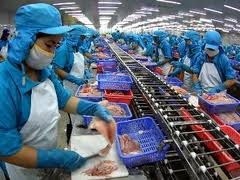Tra fish processing industry struggles to reach export goal
 Duong Ngoc Minh, Chairman of Fresh Water Fish Commission under the VASEP, said to reach the export target, farmers and export processors needed a total investment capital of VND26 trillion ($1.2 billion) to rear tra fish for export processing activities.
Duong Ngoc Minh, Chairman of Fresh Water Fish Commission under the VASEP, said to reach the export target, farmers and export processors needed a total investment capital of VND26 trillion ($1.2 billion) to rear tra fish for export processing activities.
However, they were having difficulties approaching these loans due to the state's credit tightening policy and high lending interest rate, Minh said.
"If they do not have the loans to produce tra fish soon, the export industry will fall into a situation of lacking raw materials for processing," he said.
Le Chi Binh, deputy chairman of the An Giang Fisheries Production and Processing Association (AFA), said the farmers and processors could get loans but only a fraction of what they needed. With interest rates between 14.5-15.5 per cent per year, demand for loans for production and business is increasing.
The lack of loans for production has pushed farmers into the situation of decreasing their volume of tra fish.
As result, the tra fish export processing industry has faced a lack of raw materials for processing, Minh said. Additionally, the bankrupt situations of seafood processors such as Binh An and An Khang in Can Tho City have caused a loss of trust from the farmers. The farmers have asked processors to pay money for tra fish before transporting the raw materials.
At present, regions producing raw materials have met 50 per cent of the demand on export processing, Minh said.
Almost all tra fish processors have now partly implemented the orders from their traditional customers while waiting for an increase in credit from the seafood processing industry and a reduction of lending interest rates, according to the VASEP.
For long term and sustainable development, relevant state offices should review the developing plans of regions for producing raw materials as well as developing seafood processing factories to ensure a balance between production ability and raw material output and avoid the depletion of raw materials, the association said.
The state should encourage each seafood processor to have its region of producing raw materials first.
The State should also continue its policy on reducing lending interest rates to help seafood processing enterprises as well as other production enterprises more easily get loans with low interest rates.
Shrimp exports surge
Shrimp exports in the first quarter reached $436 million, an increase of about 9.3 per cent in value over the same period last year, according to the Viet Nam Customs Department.
In March alone, $178 million worth of shrimps were shipped abroad, an increase of almost 29 per cent over February and a year-on-year increase of 13.4 per cent.
Shrimp exports to leading markets like Japan, US, mainland China and Hong Kong have achieved positive growth rates of between 13-26 per cent, according to VASEP.
Exports to Australia in the first quarter soared to $20 million, or double the value achieved in the same period last year, and the outlook is promising, the association said.
In the first quarter, Japan's shrimp import from Viet Nam hit its highest value at $113.5 million, up 17.3 per cent year-on-year. The US was the second biggest importer at $90.2 million, up 9.2 per cent, and the EU came in third at $59.7 million, down 21.8 per cent.
Shrimp exports to the three largest markets accounted for more than 60 per cent of the country's total shrimp export value in the first quarter.
What the stars mean:
★ Poor ★ ★ Promising ★★★ Good ★★★★ Very good ★★★★★ Exceptional
Related Contents
Latest News
More News
- Global partnerships key to Vietnam’s IFC development (December 26, 2025 | 16:18)
- Vingroup pulls out of bid to invest in North-South high-speed railway (December 26, 2025 | 11:42)
- Strengthening supply chains through trade promotions and customs reform (December 24, 2025 | 14:00)
- PM orders investment model for North–South high-speed rail (December 22, 2025 | 17:43)
- LS Eco Energy to invest in Vietnam rare earth sector (December 22, 2025 | 17:31)
- Government moves to establish International Financial Centre (December 21, 2025 | 21:00)
- Vietnam's IFC to target global investment flows (December 21, 2025 | 18:00)
- Two national hospitals expand capacity with new facilities (December 20, 2025 | 09:00)
- Ha Tinh breaks ground on major Vingroup industrial and energy projects (December 19, 2025 | 18:24)
- EVN launches major power infrastructure projects nationwide (December 19, 2025 | 18:17)

 Tag:
Tag:





















 Mobile Version
Mobile Version